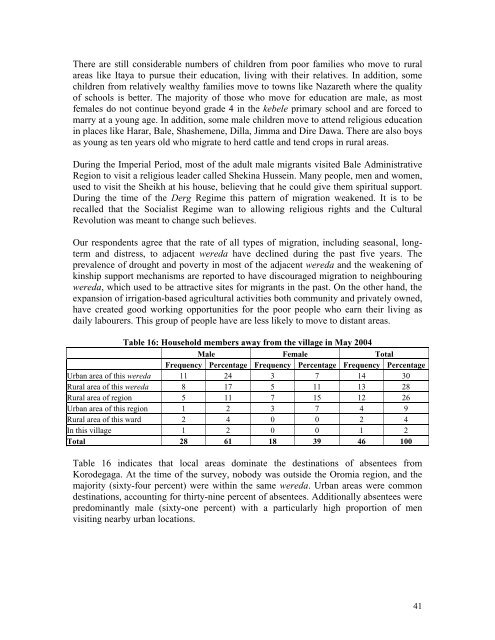Migration and Rural-Urban Linkages in Ethiopia
Migration and Rural-Urban Linkages in Ethiopia - Ethiopian Review
Migration and Rural-Urban Linkages in Ethiopia - Ethiopian Review
Create successful ePaper yourself
Turn your PDF publications into a flip-book with our unique Google optimized e-Paper software.
There are still considerable numbers of children from poor families who move to ruralareas like Itaya to pursue their education, liv<strong>in</strong>g with their relatives. In addition, somechildren from relatively wealthy families move to towns like Nazareth where the qualityof schools is better. The majority of those who move for education are male, as mostfemales do not cont<strong>in</strong>ue beyond grade 4 <strong>in</strong> the kebele primary school <strong>and</strong> are forced tomarry at a young age. In addition, some male children move to attend religious education<strong>in</strong> places like Harar, Bale, Shashemene, Dilla, Jimma <strong>and</strong> Dire Dawa. There are also boysas young as ten years old who migrate to herd cattle <strong>and</strong> tend crops <strong>in</strong> rural areas.Dur<strong>in</strong>g the Imperial Period, most of the adult male migrants visited Bale Adm<strong>in</strong>istrativeRegion to visit a religious leader called Shek<strong>in</strong>a Husse<strong>in</strong>. Many people, men <strong>and</strong> women,used to visit the Sheikh at his house, believ<strong>in</strong>g that he could give them spiritual support.Dur<strong>in</strong>g the time of the Derg Regime this pattern of migration weakened. It is to berecalled that the Socialist Regime wan to allow<strong>in</strong>g religious rights <strong>and</strong> the CulturalRevolution was meant to change such believes.Our respondents agree that the rate of all types of migration, <strong>in</strong>clud<strong>in</strong>g seasonal, longterm<strong>and</strong> distress, to adjacent wereda have decl<strong>in</strong>ed dur<strong>in</strong>g the past five years. Theprevalence of drought <strong>and</strong> poverty <strong>in</strong> most of the adjacent wereda <strong>and</strong> the weaken<strong>in</strong>g ofk<strong>in</strong>ship support mechanisms are reported to have discouraged migration to neighbour<strong>in</strong>gwereda, which used to be attractive sites for migrants <strong>in</strong> the past. On the other h<strong>and</strong>, theexpansion of irrigation-based agricultural activities both community <strong>and</strong> privately owned,have created good work<strong>in</strong>g opportunities for the poor people who earn their liv<strong>in</strong>g asdaily labourers. This group of people have are less likely to move to distant areas.Table 16: Household members away from the village <strong>in</strong> May 2004Male Female TotalFrequency Percentage Frequency Percentage Frequency Percentage<strong>Urban</strong> area of this wereda 11 24 3 7 14 30<strong>Rural</strong> area of this wereda 8 17 5 11 13 28<strong>Rural</strong> area of region 5 11 7 15 12 26<strong>Urban</strong> area of this region 1 2 3 7 4 9<strong>Rural</strong> area of this ward 2 4 0 0 2 4In this village 1 2 0 0 1 2Total 28 61 18 39 46 100Table 16 <strong>in</strong>dicates that local areas dom<strong>in</strong>ate the dest<strong>in</strong>ations of absentees fromKorodegaga. At the time of the survey, nobody was outside the Oromia region, <strong>and</strong> themajority (sixty-four percent) were with<strong>in</strong> the same wereda. <strong>Urban</strong> areas were commondest<strong>in</strong>ations, account<strong>in</strong>g for thirty-n<strong>in</strong>e percent of absentees. Additionally absentees werepredom<strong>in</strong>antly male (sixty-one percent) with a particularly high proportion of menvisit<strong>in</strong>g nearby urban locations.41




![to read the full report [pdf, Amharic] - Ethiopian Review](https://img.yumpu.com/52737829/1/190x245/to-read-the-full-report-pdf-amharic-ethiopian-review.jpg?quality=85)











